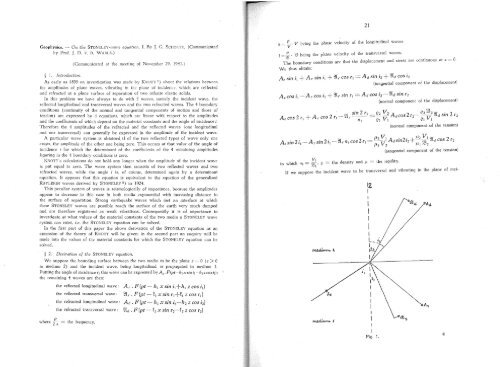V - DWC
V - DWC
V - DWC
Create successful ePaper yourself
Turn your PDF publications into a flip-book with our unique Google optimized e-Paper software.
21<br />
Geophysics. -- On the STONELEY~wave equatian. 1. By J. G. SCHOLTE. (Communicated<br />
by Prof. J. D. v. D. WAALS.)<br />
§ 1. 1 ntraduci'ion.<br />
(Communicated at the meeting of November 29, 1941.)<br />
As early as 1899 an investigation was made by KNOTT J) about the relations between<br />
the amplitudes of plane waves, vibrating in the plane of incidence, which are reflected<br />
and refracted at a plane surface of separation of two infinite e1astic solids.<br />
In this problem we have always to do with 5 waves, namely the incident wave, the<br />
reflected longitudinal and transversal waves and the two refracted waves. Thc '4 boundary<br />
conditions (continuity of the normal and tangential componcnts of motion and those of<br />
tension) are expresscd by 4 equations, which are linear with respect to the amplitudes<br />
and the coefficients of which depend on the material constants and the anglc of incidence i.<br />
Therefore tbe 4 amplitudes of the refracted and the reflected waves (one longitudinal<br />
and one transversal) can generally be expressed in the amplitude of the incident wave.<br />
A partiClJlar wave system is obtaineC\ if of the two reflected types of wave only one<br />
exists, the amplitude of the other onc being zero. This occurs at that value of the angle of<br />
incidence i far which the determinant of the coefficients of the 4 remaining amplitudes<br />
figuring in the 1 boundary conditions is zero.<br />
KNOTT's calcuJations do not hold any longer when the amplitude of the incident wave<br />
b put equal to zero. The wave system then consists of two reflected waves and two<br />
rdracted wave;;, whil.e the angle i is, of course, determined again by a determinant<br />
cquation. It appears that this equation is equivalent to the equation of the generalised<br />
RAYLEIGH waves derived by STONELEy2) in 1924.<br />
This peculiar system of waves is seismologically of importance, because the amplitudes<br />
appeal' to decrease in this case in both media cxponential with increasing distance to<br />
the surface of separation. Strong earthquake waves which met an interface at which<br />
tl!ese STONELEY waves are possible reach the surface of the earth very much damped<br />
and are therefore registered as weak vibrations. Consequently it is of importance to<br />
investigate at wh at values of the material constants ofthe two media a STONELEY wave<br />
system can exist, i.e. the STONELEY equation can be solved.<br />
In the first part of this paper the above derivation of the STONELEY equation as an<br />
extension of the theol'Y of KNOTT will. be given; in the second part an enquiry wil! be<br />
made into the values of the material constants for which the STONELEY equation cau be<br />
solved.<br />
h =t, V Leing the phase velo city of the longitudinal waves<br />
f<br />
- _'2-, sn being the phase velo city of the transversal waves.<br />
__ ~ :v<br />
d 1 t d t are continuo us at z = O.<br />
The boundary conditions are that the isp acemen an s re ss<br />
We thus obtain:<br />
Ae sin i l<br />
+- Ar sin i l + 2C· cos tI = Ad sin i2 + sn d cos iz<br />
(tangential component of the displacement)<br />
Ae cos i l<br />
- A r cos i l + 91,. sin tI = Ad cos i 2 - 91d sin r2<br />
(normal component of the displacement)<br />
+ A 2 - 21 sin~ __ ~1 =: iL2_~? Adcos 21'2- C2 ~} snel sin 2 l'2<br />
Ae cos 2 l'1 I' cos rl ' r nl Cl VI Cl VI<br />
A<br />
(normal component of the tension)<br />
f-l2 VI A . 2' +f-l2<br />
. 2' A . 2i --sn<br />
VI ()( 2<br />
n cos2l' =--=------ elSm 12 --\n"'dCOS r2<br />
esm 11-- r Sln I r I I lA.l V 2<br />
lA.l ;.02<br />
in which 111 = ~~, i2 = the density and f-l = the rigidity.<br />
(tangential component of the tension)<br />
d to be trallsversal and vibrating in the plane of inci~<br />
If we suppose the inci ent wave<br />
Ij!<br />
I<br />
§ 2. Derivatian of the STONELEY equatian.<br />
We suppose the bounding surface between the two media to be the plane z = 0 (z> 0<br />
in medium 2) and the incident wave, beiug longitudinal, is propagated in medium 1.<br />
Putting the angle of incidence ij this wave can be expressed by Ae' F(pt---h j xsini j - hl zcasÎI);<br />
the remaining 4 waves are then:<br />
the reflected longitudinal wave: A,.. F (pt -- hl X sin i 1 + hl Z cos i l<br />
)<br />
the reflected transvel'saI wave: 91,.. F (pt -- l\ X sin tI +fl Z cos tI)<br />
the l'efracted Iongitudinal wave: Ad. F (pt -- h 2<br />
X sin i 2<br />
--h 2<br />
Z cos i 2<br />
)<br />
the refracted transversal wave:<br />
p<br />
w here ---,' = t<br />
2][<br />
h' e frequency,<br />
Fig. 1.

















